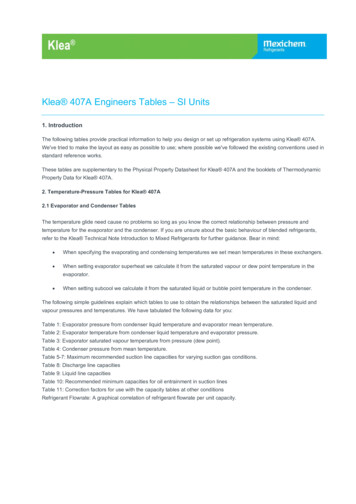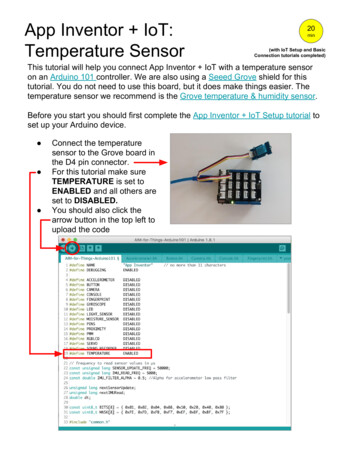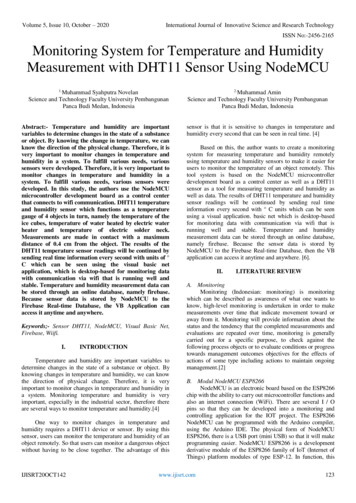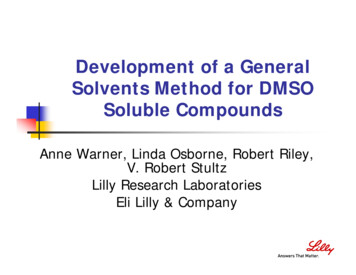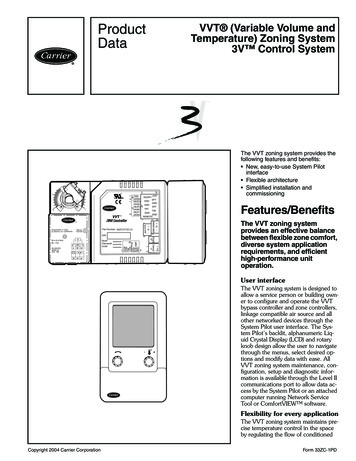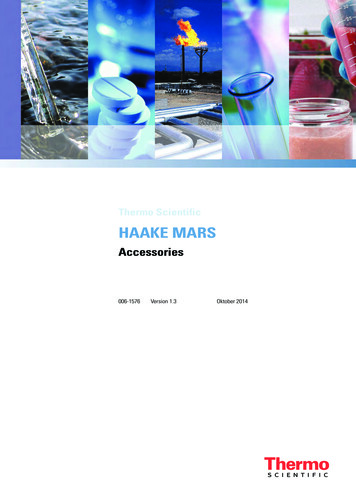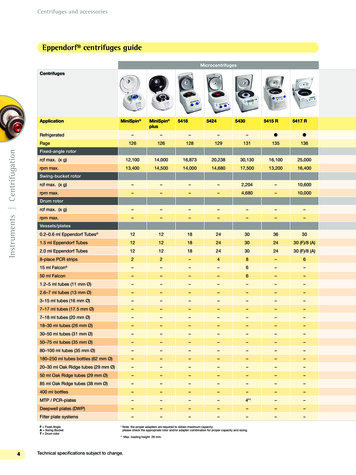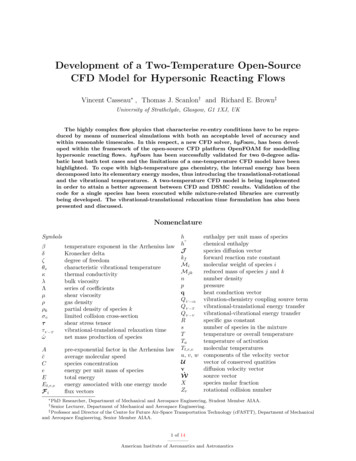
Transcription
Development of a Two-Temperature Open-SourceCFD Model for Hypersonic Reacting FlowsVincent Casseau , Thomas J. Scanlon† and Richard E. Brown‡University of Strathclyde, Glasgow, G1 1XJ, UKThe highly complex flow physics that characterise re-entry conditions have to be reproduced by means of numerical simulations with both an acceptable level of accuracy andwithin reasonable timescales. In this respect, a new CFD solver, hyFoam, has been developed within the framework of the open-source CFD platform OpenFOAM for modellinghypersonic reacting flows. hyFoam has been successfully validated for two 0-degree adiabatic heat bath test cases and the limitations of a one-temperature CFD model have beenhighlighted. To cope with high-temperature gas chemistry, the internal energy has beendecomposed into its elementary energy modes, thus introducing the translational-rotationaland the vibrational temperatures. A two-temperature CFD model is being implementedin order to attain a better agreement between CFD and DSMC results. Validation of thecode for a single species has been executed while mixture-related libraries are currentlybeing developed. The vibrational-translational relaxation time formulation has also beenpresented and kσvττV Tω̇temperature exponent in the Arrhenius lawKronecker deltadegree of freedomcharacteristic vibrational temperaturethermal conductivitybulk viscosityseries of coefficientsshear viscositygas densitypartial density of species klimited collision cross-sectionshear stress tensorvibrational-translational relaxation timenet mass production of speciesAc̄CeEEt,r,vFipre-exponential factor in the Arrhenius lawaverage molecular speedspecies concentrationenergy per unit mass of speciestotal energyenergy associated with one energy modeflux vectorsh hJkfMiMjknpqQV chQV TQV VRsTTaTt,r,vu, v, wUvẆXZrenthalpy per unit mass of specieschemical enthalpyspecies diffusion vectorforward reaction rate constantmolecular weight of species ireduced mass of species j and knumber densitypressureheat conduction vectorvibration-chemistry coupling source termvibrational-translational energy transfervibrational-vibrational energy transferspecific gas constantnumber of species in the mixturetemperature or overall temperaturetemperature of activationmolecular temperaturescomponents of the velocity vectorvector of conserved quatitiesdiffusion velocity vectorsource vectorspecies molar fractionrotational collision number PhDResearcher, Department of Mechanical and Aerospace Engineering, Student Member AIAA.Lecturer, Department of Mechanical and Aerospace Engineering.‡ Professor and Director of the Centre for Future Air-Space Transportation Technology (cFASTT), Department of Mechanicaland Aerospace Engineering, Senior Member AIAA.† Senior1 of 14American Institute of Aeronautics and Astronautics
Subscripts and oductionigh-speed vehicles flying at altitudes around ten times higher than today’s aircraft represent a futureHvision of air-space transportation. From an engineering, environmental and societal viewpoint, considerable obstacles remain to be resolved to make this future a reality. One of the barriers that needs to be1overcome concerns the thorough understanding and characterisation of the aerothermodynamic flow conditions experienced by the vehicle as it enters the Earth’s atmosphere.2 This point is of crucial importance topreserve the integrity of the aircraft in the searing conditions of the descent phase.The highly complex flow physics that characterise re-entry conditions have to be reproduced by meansof numerical simulations with both a good level of accuracy and within reasonable timescales. Hypersonicre-entry vehicle flow fields at intermediate altitudes - ranging from 60 to 80 km - contain a mixture ofcontinuum and non-continuum (rarefied) regions. Navier-Stokes solutions using conventional computationalfluid dynamics (CFD) are appropriate for continuum flows but fail to accurately predict non-continuumflow behaviour. Conversely, the direct simulation Monte Carlo (DSMC) particle-based methodology is thepreeminent technique for rarefied flows but requires significant computational effort when solving continuumregions. The craft may also encounter a chemically reacting environment that can have a significant influenceon aerodynamic performance and surface heating. Numerical models that fail to incorporate such reactingflows miss an essential part of the flow physics surrounding the vehicle.The need for reliable numerical tools that can capture thermochemical non-equilibrium with high-fidelityhas gained momentum recently, principally due to NASA’s upcoming critical missions involving the nextCrew Exploration Vehicle, Orion,3 and complex systems to allow high-mass payload entries in the Martian atmosphere.2 Among the most popular CFD codes dedicated to the study of the hypersonic regimeare NASA’s DPLR4 (Data-Parallel Line Relaxation) and LAURA5 (Langley Aerothermodynamic UpwindRelaxation Algorithm), VULCAN6 (Viscous Upwind aLgorithm for Complex flow ANalysis), US3D7, 8 (UnStructured 3D) of the University of Minnesota, and LeMans9, 10 (the Michigan Aerothermal Navier-StokesSolver) of the University of Michigan. They have all adopted a similar strategy to cope with thermochemicalnon-equilibrium where the gas mixture is no longer described by a single temperature but by at least twodistinct molecular temperatures.11 These temperatures are derived from the decomposition of the internalenergy into its elementary energy modes thus distinguishing the translational-rotational temperature fromits vibrational counterpart. Each of the CFD codes described above contain differences which are mainlydue to the distinct representation of energy exchange between the energy modes.3In order to address the issues described above a new CFD solver has been developed within the frameworkof the open-source CFD platform OpenFOAM12 for modelling hypersonic reacting flows. Contributions ofcompeting mechanisms are considered in isolation by focusing on a 0-degree adiabatic heat bath and byvalidating the chemistry module independently from the two-temperature model. Lack of experimental orflight data and uncertainties in the determination of reaction rates and relaxation times force us to reflectupon any comparisons between the CFD and DSMC results, DSMC being often regarded as an experimentalanalogue. Hence, the DSMC solver, dsmcFoam, developed and validated13, 14 at the University of Strathclyde,will serve as a benchmark tool for the validation of our CFD code. The code possesses new features such asthe ability to model the vibrational internal energy mode and adopts the Quantum Kinetic approach, recentlyintroduced by Bird, for chemical reactions.15 Post-collision energy redistribution between the internal energymodes is executed using the Larsen-Borgnakke procedure.13, 162 of 14American Institute of Aeronautics and Astronautics
II.MethodologyThe work that has been carried out within OpenFOAM can be split into two main sections. The firstconsisted of improving and validating the current chemistry module using a standard one-temperature model.This then set the basis for a two-temperature CFD arrangement. These are the two stages that are presentedin the following sub-sections. Ultimately, the chemistry part and the new thermodynamic libraries will bereunited to form a two-temperature solver for simulating high-temperature reacting mixtures.A.Chemistry solverA suitable OpenFOAM CFD solver, rhoCentralFoam, has first been identified and assessed. This solverhas been created to resolve high-speed compressible flows,17 making use of central-upwind interpolationschemes of Kurganov and Tadmor.18 It has produced comparable results to those given by the MISTRALflow solver,19 for continuum hypersonic simulations over a hollow cylinder.20 Basic chemistry features havebeen added to rhoCentralFoam by incorporating parts of the solver reactingFoam, an OpenFOAM solverdealing with combustion. This enables us to include chemical reactions along with their type and ratesand to introduce quantities related to the species mixture, such as mass fraction or number density. Thenewly blended code has been given the name hyFoam. The solution process then consists of resolvinga set of ordinary differential equations (ODE) and species mass fractions. Validation of the new codeimplementation has been carried out by initially considering the reversible reaction of hydrogen and iodine *to produce hydrogen-iodide in the reaction I2 H2 ) 2HI. This chemical reaction occurs at constanttemperature and an analytical solution of the species concentration over time can be easily derived.21 Theforward and reverse rate constants at T 700 K are also to be found in the aforementioned reference.Species concentrations plotted with respect to time for both the analytical solution and hyFoam are shownin Figure 1. The results demonstrate a highly satisfactory agreement thus validating this first stage of thenew hyFoam solver implementation.Species concentration, CHI, CI2 , CH2 [mol / m3]876I2 H2 2HI5C0I24 C0H 4.54 mol / m32analyticalhyFoam32100510152025Time, t [h]Figure 1. Species concentration versus time for a chemically reacting H2 - I2 reservoir at a constant temperatureof 700 K and an initial pressure of 0.528 atm.However, these basic chemistry features are insufficient to accurately model high-temperature dissociatinggas mixtures. In order to mitigate this problem, a two-temperature approach has been adopted, making adistinct juncture between the translational-rotational and vibrational temperatures.223 of 14American Institute of Aeronautics and Astronautics
B.1.Governing equationsTwo-temperature modelDecomposition of the internal energy into its elementary energy modes is a consequence of the BornOppenheimer approximation.23 Although its validity has been debated by Giordano,24 this approach undoubtly remains the reference as it has proved to give satisfactory results for numerous re-entry case scenarios.25, 26, 27 Moreover, as Bird has indicated, when it comes to the numerical modelling of a physicalphenomenon, a gain in physical realism does not necessarily translates into improved results.15The study of the ionised flow-field is outside of the scope of this paper and as such the electron-electronicenergy mode is disregarded in the following. The total energy, E, can be decomposed as the sum of thekinetic, translational, internal, and chemical energies as follows28E 1ρui ui2 sXEt,k k 1sXEr,k k 1sXEv,k k 1sX ρk hk(1)k 1where indices t, r, and v refer to translational, rotational, and vibrational energy modes, respectively. k isan index to vary between 1 and the number of species in the mixture, s. ρ is the mixture density and ui fori to vary between 1 and 3 denotes one of three components of the velocity vector. ρk stands for the partial density of species k and hk is the standard enthalpy of formation of species k. In particular, the relationbetween the vibrational energy, Ev , and the vibrational energy per unit mass of species k, ev,k , is given byEv sXsXEv,k k 1ρk ev,k(2)k 1The translational and rotational energy modes are fully excited below a few tens of Kelvin and therelaxation towards equilibrium of the translational and rotational temperatures, denoted by Tt and Tr ,respectively, is known to be achieved within a small number of particle collision events.15 Hence, Tt andTr are considered to be identical, called the translational-rotational temperature, and designated by Ttr .Depending on the type of particle under investigation, the internal energies per unit mass of species may bewritten as et,m 3/2 Rm Ttret,a 3/2 Ra Ttr eer,m Rm Ttr 0r,a(3)molecule matom a(4)Rm θv,m e e 0 θv,m v,m v,aexp Tv,m 1where R is the specific gas constant, equal to the ratio of the universal gas constant divided by the molecularweight of the particle, and θv is the characteristic vibrational temperature of the particle of interest. Asimple harmonic oscillator is employed for the vibrational mode.15Coupling between the translational-rotational and vibrational energy modes, denoted by Qk,V T , isthen quantified using the Landau-Teller equation.29 This equation prescribes the translational/rotationalvibrational (V-T) energy exchange rate and thus the time rate of change in vibrational energy as followsQk,V T ρk ev,k (Tv,k )ev,k (Ttr ) ev,k (Tv,k ) ρk tτk,V T(5)where τk,V T is the molar averaged V-T relaxation time.Millikan and White30 proposed a semi-empirical correlation to estimate the V-T relaxation time for alarge variety of species. The formula is valid for temperatures within the range [300; 8, 000] K. In the worstcase scenario divergence from the experimental measurements is observed up to a factor of 5. For a mixture,this yieldsτk,V T τkM W 1sX Xj /τjk,V T j 14 of 14American Institute of Aeronautics and Astronautics(6)
where X is the species molar fraction and the interspecies relaxation times, τjk,V T , can be written asτjk,V T h i1 1/31/4exp Ajk Ttr 0.015Mjk 18.42 with p in atmp(7)Coefficient Ajk and the reduced mass of species j and k, Mjk , are given byAjk 1.16 10 3Mjk p4/3Mjk θv,k(8)Mj MkMj Mk(9)where Mk is the molecular weight of species k in g/mol.Park added a correction factor to the Millikan-White formula31 to take into account the inaccurateestimation of the collision cross-section at high temperatures. The V-T relaxation time is now defined byτk,V T τkM W τkP(10)where the collision-limited relaxation time, τkP , is a function of the average molecular speed, c̄k , the limitedcollision cross-section, σv , and the number density as followsτkP 1c̄k σv nk(11)with 250, 0008 Rk Ttrandσv 10 21(13)(12)TtrπVibrational-vibrational coupling, QV V , and chemistry-vibration coupling, QV ch , are beyond the scopeof this paper and will be implemented and investigated in future studies.Finally, the overall temperature, T , is reconstructed considering a formula involving molecular temperatures and their respective degrees of freedom. This may be written asrc̄k T 3 Tt ζ̄int Tint3 ζ̄int(14)An analogous expression can be found in Bird’s book15 to determine the overall temperature from anyDSMC computations. The subscript int refers to the internal energy modes which are in the present casethe rotational and vibrational modes. ζ is the number of degrees of freedom in relation to one specificenergy mode. Both translational and rotational energy modes are supposed to be fully excited, therefore,three degrees of freedom are allocated to the translational mode and ζt 3. Neglecting the degree offreedom of rotation along the nuclear axis for diatomic molecules, two degrees of freedom are associated withthe rotational energy mode if the particle is a molecule. Different values taken by ζ can be derived fromequipartition theory, with11ander ζr R Ttr(15)ev ζv R T v(16)22where ζ̄int is the mass-weighted average of ζr and ζv .2.Non-equilibrium Navier-Stokes-Fourier equationsThe Navier-Stokes-Fourier (NSF) equations are solved to compute transient compressible reacting flows.These are presented below in flux-divergence form for the s species transport and reaction equations, themomentum equations, the vibrational energy equation, and the total energy equation. It states U F i Ẇ t xi(17)where the vector of conserved quantities, U , writesU (ρ1 , ρ2 , · · · , ρs , ρu, ρv, ρw, Ev , E)T5 of 14American Institute of Aeronautics and Astronautics(18)
u, v, and w are the three components of the velocity vector. The flux vectors, ρ1 ui J1, i ρ2 ui J2, i . . ρs ui Js, i ρui u δi1 p τi1 Fi ρui v δi2 p τi2 ρui w δi3 p τi3 s X Eu q Ev,k vk,iv iv,i k 1 3s (E p)u X τ u q q X h Jiij jtr,iv,ij 1kF i , are given by k,i (19)k 1where index i refers to one of the three dimensions of space and δ is the Kronecker delta. hk stands for theenthalpy per unit mass of species k. τ is the shear stress tensor and Stokes’ hypothesis for the bulk viscosityis assumed to hold. Thus ui uj uk2τij µ(20) λδijwith λ µ xj xi xk3where µ is the shear viscosity and λ is the bulk viscosity.Components of the heat conduction vector, q, are assumed to follow Fourier’s heat lawqtr,i κtr Ttr xiqv,i κv Tv xi(21)where the thermal conductivity κ is decomposed into translational-rotational and vibrational contributions.Please refer to Ref. 28 for further detail.Jk, i are the components of the species diffusion vector for species k defined as the product of the partialdensity ρk and the corresponding component of the diffusion velocity vector, vk,i . Their implementation inthe OpenFOAM framework is planned in due course. Therefore, it can be considered in the following thatdiffusion velocities are equal to zero.The source term vector, Ẇ, is given below!TsX Ẇ ω̇1 , ω̇2 , · · · , ω̇s , 0, 0, 0,Qk,V T Qk,V V Qk,V ch , 0(22)k 1where ω̇k is the net mass production of species k.III.A.ResultsOne-temperature chemistry solver validation at high temperaturesA 0-degree adiabatic heat bath considering relaxation towards thermochemical equilibrium provides a goodbenchmark case to check how well the new hyFoam CFD code performs in relation to high-temperature gaschemistry. The test case is composed of a single cubic cell of length 1 10 5 m and initial pressure of 0.063atm. Five different initial temperatures have been considered to cover a range of temperatures during themolecular dissociation, these being T 0 {5, 7.5, 10, 15, 20} 103 K. The time-step for CFD computationshas been set at 2 10 9 s.The chemical reaction considered is the irreversible molecule-molecule dissociation of oxygenkf (T )O2 O2 2O O2The forward rate constant, kf , is assumed to follow the Arrhenius law, and is thus expressed by Takf (T ) A T β exp T6 of 14American Institute of Aeronautics and Astronautics(23)
where A is a pre-exponential factor, β is the temperature exponent, and Ta is the temperature of activationderived from the activation energy. The units of A and Ta are given in m3 /mol/s and Kelvin, respectively.Three sets of forward rate constants are employed : rates from Quantum Kinetic (QK) theory,13 rates fromthe Dunn and Kang (DK) experiments,32, 33 and Park’s rates for the use of a two-temperature model (P2T).31A single temperature has been employed to represent all of the internal modes and the rate coefficients areshown in Table 1.Table 1. Parameters for the evalution of kfReaction rateQKDKP2TArrheniusA3.21 10193.24 10192.0 1021law constantsβTa-1.0 59,370.6-1.0 59,883.0-1.5 59,500.0In the DSMC calculations, an ensemble average of three statistically-independent solutions has beencarried out. The time-step for DSMC computations has been set at 1.52 10 9 s as prescribed in Ref. 13.The comparisons between hyFoam and dsmcFoam are shown in figures 2(a) and 2(b). Results using DK ratesare not displayed for reasons of clarity. P1T refers to P2T reaction rates when using a single-temperaturemodel. Firstly, considering the QK rates for an initial temperature of 10, 000 K, the hyFoam predictionsare seen to be in excellent agreement with those provided by Boyd’s analytical code.13 hyFoam has thusbeen validated for a single, irreversible chemical reaction of dissociation involving O2 . However, it is evidentthat none of the reaction rates presented in Table 1 demonstrate a satisfactory agreement between CFDand DSMC results. For each initial temperature considered, the rate of change in temperature and speciesconcentration is overpredicted using the CFD one-temperature model. This benchmark case illustrates thelimitations of a one-temperature model for the study of dissociating mixtures. According to Bird,15 ”thequantum treatment of vibration permits a physically realistic treatment of dissociation (p.52).” Therefore,it is essential to quantify the vibrational energy mode, i.e., split the internal energy into its separate energymodes, and to model the energy exchange between these modes. It is this two-temperature formulation thatis discussed for single-species gases in the two subsequent paragraphs.B.Vibrational-Translational relaxation of a single-species gasThe single-temperature OpenFOAM CFD solver hyFoam serves as the foundation of the newly coded solverhy2Foam that incorporates the two-temperature model. The 0-degree adiabatic heat bath will again providea first benchmark case for the validation of the implementation of the two-temperature model. Emphasisis made on vibrational-translational (V-T) relaxation. For this purpose, the same single cubic cell filledwith O2 is now set-up with different initial translational and vibrational temperatures. The translationaltemperature is set to 20, 000 K while the vibrational temperature is lowered to 300 K. To further simplify theproblem and solely investigate V-T energy transfers, chemical reactions of dissociation are disabled. Thus,the gas is composed of a single species.dsmcFoam intrinsically has three temperatures : translational, rotational, and vibrational. However, inthe event of a rotational collision number, Zr , set to unity, the rotational energy mode will always be in astate of thermal equilibrium and Tr will equal Tt to form Ttr . Tuning the value of Zr allows us to drawa direct comparison between the dsmcFoam and hy2Foam CFD results. Other CFD and DSMC settingsremain unchanged.Due to the inherent uncertainties arising from the experimental determination of the vibrational-translational relaxation time, τV T , it is considered unlikely that the Millikan-White correlations with (MWP)or without (MW) Park’s correction will match DSMC results. Therefore, an attempt is made to derive thetime evolution of τV T from DSMC simulations to later decide on the validity of hy2Foam implementation.Equation 5 is employed and working backwards : knowing the Ttr (t) and Tv (t) profiles, the vibrationalenergy and its time derivative are computed. This yields in a system of a single equation with one unknownwhose result is depicted with crosses shown in Figure 3. A curve-fitted profile denoted by the solid line isdrawn and is then injected into CFD calculations. As expected, it can be seen that MW correlations clearlyunderpredict the value of τV T .7 of 14American Institute of Aeronautics and Astronautics
1Dimensionless temperature, T / T00.90.80.70.60.50.40.310-910-810-710-6Time, t [s]10-510-410-3(a) Gas mixture overall temperature distribution versus time0.82Number density, nO / n010.60.40.210-910-810-710-6Time, t [s]10-510-410-3(b) O2 molecule concentration versus timeFigure 2. Dissociation of an O2 reservoir from a given initial temperature and a pressure of 0.063 atm. Thecrosses are the ensemble averages resulting from DSMC computations. The solid and dashed lines displaythe results using hyFoam CFD solver along with QK and P1T rates, respectively. The violet dashed-dottedline is the distribution resulting from the use of the analytical code of Boyd. Initial temperatures T 0 {5, 7.5, 10, 15, 20} 103 K are associated with colors yellow, red, violet, dark blue, and black, respectively.This results in vibrational relaxation to equilibrium at an excessive pace. Adding Park’s correction forhigh temperature mixtures does contribute to significantly increasing the V-T relaxation time but it does nottranslate into a better concordance with DSMC data for this set of initial conditions. A significant departurefrom the DSMC data is observed for t no greater than 3 10 7 s so that a slower thermal relaxation isalso evident for quantities such as the molecular temperatures and pressure as shown in Figure 4. Thesediscrepancies are easily understood by the fact that temperatures are outside of the temperature rangesuitable for the MW correlation and by the very strong degree of thermal non-equilibrium that this casescenario presents.In Figure 4, both molecular temperatures and pressure profiles are in excellent concurrence with DSMCresults. MW and MWP simulations achieve a state of thermal equilibrium 2.5 times faster and 1.08 times8 of 14American Institute of Aeronautics and Astronautics
V-T relaxation time, τV-T[s]2 x 10-610-64 x 10-710-910-810-7Time, t [s]10-610-5Figure 3. V-T relaxation time parameter versus simulation time for an O2 reservoir from an initialtranslational-rotational temperature of 20, 000 K, vibrational temperature of 300 K, and a pressure of 0.063atm. The crosses are ensemble averages resulting from the use of DSMC data to recover τV T . The solid linerepresents the curve-fitted profile. The dashed line and dashed-dotted line display the results using MW andMWP correlations, respectively.6.4615Pressure, p [kPa]Temperature, Ttr , Tv , T [K x 103]20105.65.254.8010-910-810-7Time, t [s]10-610-5(a) Translational (black), vibrational (red), and overall (blue)temperatures distributions versus time4.410-910-810-7Time, t [s]10-610-5(b) Pressure distribution versus timeFigure 4. V-T relaxation of an O2 reservoir from an initial translational-rotational temperature of 20, 000 K,vibrational temperature of 300 K, and a pressure of 0.063 atm. The crosses are ensemble averages resultingfrom DSMC computations. Any solid lines represent hy2Foam results using DSMC’s τV T curve-fitted profile.Any dashed lines and dashed-dotted lines display the results using MW and MWP correlations, respectively.slower, respectively (defined as the time to recover 99 % of the equilibrium temperature). The initial disturbed system restores to a state of equilibrium at a temperature of 14, 600 K. The equilibrium temperaturerecovered is identical for CFD and DSMC. Following the formulae provided in Ref. 15, the number of vibrational degrees of freedom associated with the simple harmonic model of vibration in oxygen at 14, 600 K isζv 1.849. The total number of degrees of freedom is thus equal to ζt ζr ζv 6.849. A straightforwardcalculation from the value taken by the equilibrium temperature then allows us to determine that the initialenergy pool was set at a temperature of 14, 600 6.849/5 19, 999 K. Results are thus consistent withenergy equipartition.9 of 14American Institute of Aeronautics and Astronautics
Other case scenarios have been tested by varying the initial translational-rotational temperature for O2(Figure 5(a)) or changing the species to be N2 or NO (Figure 5(b)). The initial number density was heldconstant and equal to n0 2.282 1022 m 3 . Conclusions similar to the previous paragraph can be drawnregarding the use of MW correlation and DSMC results to recover τV T . As for the MWP correlation, the0thermal relaxation becomes faster for Ttrno greater than 15, 000 K and the specific case of the N2 molecule.More generally MWP is to be prefered to MW for each of these case scenarios.20Temperature [K x 103]Ttr15105Tv010-910-810-710-610-510-4Time, t [s]0(a) Molecular temperatures distributions versus time for different Ttr20Temperature [K x 103]Ttr15O2NO10N25Tv010-910-810-7Time, t [s]10-610-5(b) Molecular temperatures distributions versus time for different moleculesFigure 5. V-T relaxation of a heat bath considering several initial translational-rotational temperatures andeach of the three molecules composing a five-species air mixture. The symbols are ensemble averages resultingfrom DSMC computations. Any solid lines represent hy2Foam results using DSMC’s τV T curve-fitted profile.Any dashed lines and dashed-dotted lines display the results using MW and MWP correlations, respectively.Therefore, hy2Foam results shown in Figures 4 and 5 validate the implementation of the two-temperatureCFD model for a single-species gas.10 of 14American Institute of Aeronautics and Astronautics
C.Discussion on the V-T relaxation timeIn DSMC computations, the rotational collision number was set to unity to enable a direct comparisonbetween the DSMC and CFD results. Thus, the translational and rotational energy pools were consideredto be in thermal equilibrium after a single particle collision event. While this restriction has shown to bevery useful to validate the implementation of hy2Foam, a typical value of 5 is usually adopted.15 In thislatter case, the V-T relaxation time will differ from the case Zr 1 due to rotational-translational androtational-vibrational energy transfers.Since no current correlation model can satisfactorily predict case scenarios that depart significantly fromweak non-equilibrium conditions, it is thought that the DSMC method could mitigate this gap. Indeed, thedetermination of the V-T relaxation time from DSMC computations seems to be promising. It has yieldedto a very satisfactory agreement for a given set of initial conditions. The question is whether a generalisationto any degree of thermal non-equilibrium is possible.A preliminary formulation is proposed in Equation 24 for a single-species gas. It takes the form of theMillikan-White correlation, corrected by Park, and introduces a series of coefficients Λ to tune accordingly.The vibrational temperature now enters into the calculation of the V-T relaxation time and aims at modellingcases with various degrees of non-equilibrium.#"r 1/4 Λ !MiMiTv,i eΛg4/3ΛbΛa Ttr Λc Λd Λf (24)p τi,V T exp θv,i22θv,ic̄i σv niFollowing Equation 24, Table 2 shows values of the various parameters used to produce the results shownin Figures 3, 4, and 5. Case scenarios 1-4 are reported in Figure 6(a). Kim and Boyd34 have performed amaster equation analysis for N N2 considering an adiabatic heat bath in strong and weak non-equilibrium 1/3exhibit a similar trendconditions. It can be observed that the different profiles of p τV T versus Ttrto those presented in the aforementioned paper. The slope of DSMC best fi
Each of the CFD codes described above contain di erences which are mainly due to the distinct representation of energy exchange between the energy modes.3 In order to address the issues described above a new CFD solver has been developed within the framework of the open-source CFD platform OpenFOAM12 for modelling hypersonic reacting ows.
